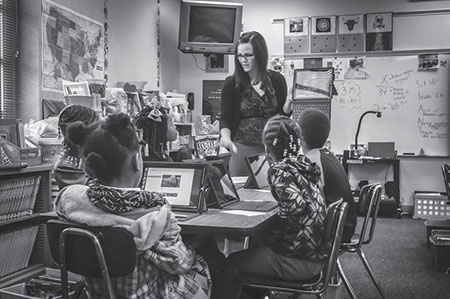SAFEKEEPING IN 2017

In the days following the presidential election, the press reported an uptick of cyberbullying. We’re happy to say that the schools we spoke with did not share that experience. Still, it’s always the right time to take stock of your security practices and make sure they are still working for your district. If you’re in need of some new methods, here are a few to check out.
BE PROACTIVE—NOT REACTIVE
“We’re not just monitoring chats these days,” says Michael Estrada, chief technology officer at South Plainfield (NJ) School District. “Since our students collaborate online we have to worry about documents, emails, pictures they save, and content they post.” For instance, is a student using the word gun for a report or is he talking about bringing one to school? Estrada says students also use Google survey tools to determine “which girl is ugliest” and other inappropriate things.
On the plus side, Estrada says he doesn’t suffer from sleepless nights because his district uses Lightspeed Web Filter 3.0. “You used to look at this stuff on a per-issue basis, but today the amount of searching is 20 times more than it ever was. With cyberbullying, you have to be more proactive than reactive and find it before it becomes an issue.”
South Plainfield has been 1:1 for a few years, so it is comfortable with maintaining control in a mobile environment. At first, teachers walked around the classrooms to make sure students were on task. With Lightspeed’s tools, teachers can see the students’ screens on their own laptops and can use the filter to do what they need, whether that’s blocking Wikipedia or blocking every site except the one they are using in that session. They can also override blocks created by Estrada’s department, which makes everyone happy.
Estrada recommends that schools use third-party vendors to handle their security. “Schools don’t have enough time to go through emails or even do word searches. They are too busy handling the day-to-day,” he says. Instead, he suggests talking with other districts to see which products they use. “You don’t have to reinvent the wheel. Look around; ask your county and state committees what works for them. Let your contacts do the vetting.”
FOCUS ON DIGITAL CITIZENSHIP
Omaha students learn about creating smart digital footprints. Last year, Omaha (NE) Public Schools (OPS) used the Houston Independent School District model and bought Surface Pro tablets and wireless displays for their secondary teachers. The district currently has an RFP to buy devices for secondary students. But before everyone has computers in their hands, the district devised a sound security strategy.
“We passed the largest bond in our history three years ago and decided to create standardization of storage, access, and devices to be able to standardize security,” says Rob Dickson, executive director. “Now we are focusing on digital citizenship to make sure our devices are secured.”
The person spearheading the charge is Keegan Korf, lead teacher for digital citizenship and regional manager for Common Sense Media. “I talk with every principal about his or her plans to address digital citizenship, which includes cyberbullying,” says Korf. “We are helping them provide instruction to create a positive digital footprint and a great reputation online. That needs to be taught with intention at our schools.”
As part of the district’s partnership with Microsoft, every school can have one to three educators become a Microsoft Innovative Educator (MIE). Korf was able to incorporate Common Sense Media’s digital citizenship curriculum into the MIE program so the teachers also became Common Sense Media knowledge experts and will teach about digital citizenship in their schools. “Every school will earn Common Sense Media digital citizenship certification this year. We’re using it as an opportunity to talk about preventing cyberbullying, creating a positive digital footprint, and turning students from bystanders into upstanders,” she says.
For more information on the Common Sense K-12 Digital Citizenship curriculum, go to www.commonsensemedia.org/educators/scope-and-sequence.
TOOLS THEY USE OMAHA (NE)
► Acer Aspire Switches
► Canvas and Microsoft Classroom
► Infinite Campus
► Microsoft School Data Sync
► Microsoft Surface 3s
► Office 365
OUTSOURCING TO EXPERTS
Ralph Barca, chief technology officer at Edison Township (NJ) Public Schools, believes in a multilayered approach when it comes to security. “We do a lot of education and have firewalls, policies, content filtering, and more,” he says. But the key to his operation is Gaggle Safety Management.



Gaggle Safety Management reviews student content 24/7, sorts incidents by severity, investigates incidents when necessary, and makes sure students stay on track. If something gets flagged, Barca gets contacted so he can bring it to the school administrator or central office. “We try to leave it at the school level since they know their students,” he says. “The principals and guidance counselors understand their children and the dynamics of the school, which gives us insight into how to handle things.”
“It might just be two students having a little war of words and saying ‘punch me’ as a joke, or it may become escalated. Today’s students love writing everything down, and a phrase like ‘kill me now’ takes on a different tone when it’s spoken versus written out.”
The Safety Management program is integrated into G Suite (formerly Google Apps for Education) so it monitors email, Google Drive, calendar events, and Google Docs. If students share docs, the district can catch something that needs to be caught. Barca appreciates that if the algorithm picks up a trigger word or phrase, a person reads the content and makes a note before he receives it. As he explains, “There’s a scale of severity. Once Gaggle called us at 2:30 a.m. to report that a child was in a critical mental state. We had Gaggle reach out to authorities and the police handled the situation. It’s all about bringing awareness.”
There are the occasional false positives but Barca would rather be safe than sorry. “Social media allows children to be a little freer with their speech. Gaggle’s 24/7 monitoring gives us that extra layer of security. It’s been a godsend for us and helps us when we speak to parents.”
It’s a major financial investment, as the district is completely 1:1 with every student account covered, but Barca believes that it is part of the responsibility in providing a take-home device.
TOOLS THEY USE
EDISON TOWNSHIP (NJ)
► Gaggle
► Discovery Education
► E-Harcourt
► Genesis
► Google Classroom
► HP Chromebook 14s
► Instructure Canvas
► IPad Airs
► i-Ready
► Lexia Core5
► Learning A-Z: Reading A-Z, RAZ Kids
► MacBook Airs
► Newsela
► Plato
► Splash Math
► STAR Assessments
► Study Island
► TenMarks
► ThinkCentral
KEYWORDS AND TRIGGERS
The tech department at Ignacio School District uses several tools to monitor student online behavior. At Ignacio (CO) School District, the three-person technology staff relies on technology to help keep its 800 students safe. Every day, there can be up to 1,000 devices on the network—thanks to a 1:1 program for grades 3 through 12, a computer lab for grades K through 2, and BYOD. “We allow our high school students to bring their cell phones to class,” says Technology Director Brian Crane. “It’s a way to teach them responsibility.”

One of the ways Crane is trying to protect students is by setting up Gmail filters for certain keywords. If those keywords get used, the technology department is automatically notified and forwards the email to the school principal, counselor, or other appropriate authority. “It creates an awareness for the students, knowing that we can see their emails. I think doing this has helped prevent potential issues.”
Another step the district has taken is to use Impero for remote management and monitoring of student computers. It helps keep students on task and lets the teacher make sure students are working on the assignment and not checking Instagram. Crane says it’s been very valuable and that he no longer has to leave his office to do repairs, since he can see what’s happening from his computer. He also uses it to spot check. “A trigger will tell me that a student is searching for suicide, and I can pop on and see if they are doing school work, research, or calling out for help.”
TOOLS THEY USE
IGNACIO SCHOOL DISTRICT (CO):
► G Suite for Education
► Impero Software
► Dell (Windows 10 Machines)
► CTL Education Chromebook
► Cyberschool powered by IES
► Extreme Networks (for LAN and wireless connectivity)
► Infinite Campus
Tech & Learning Newsletter
Tools and ideas to transform education. Sign up below.











